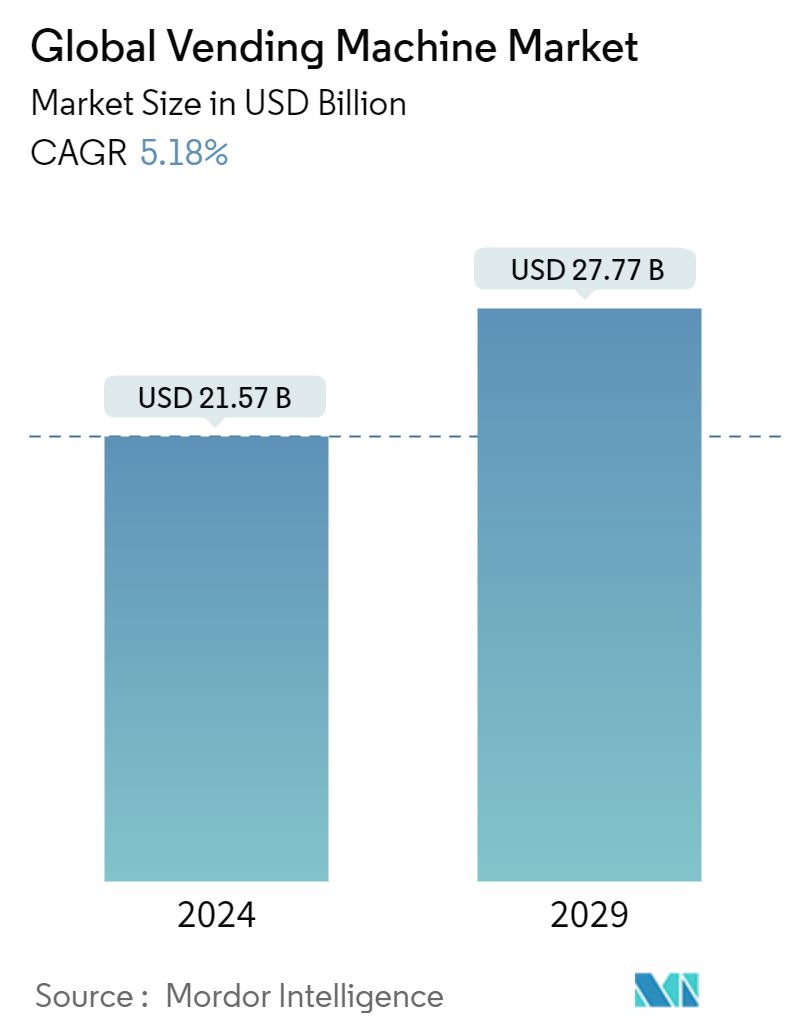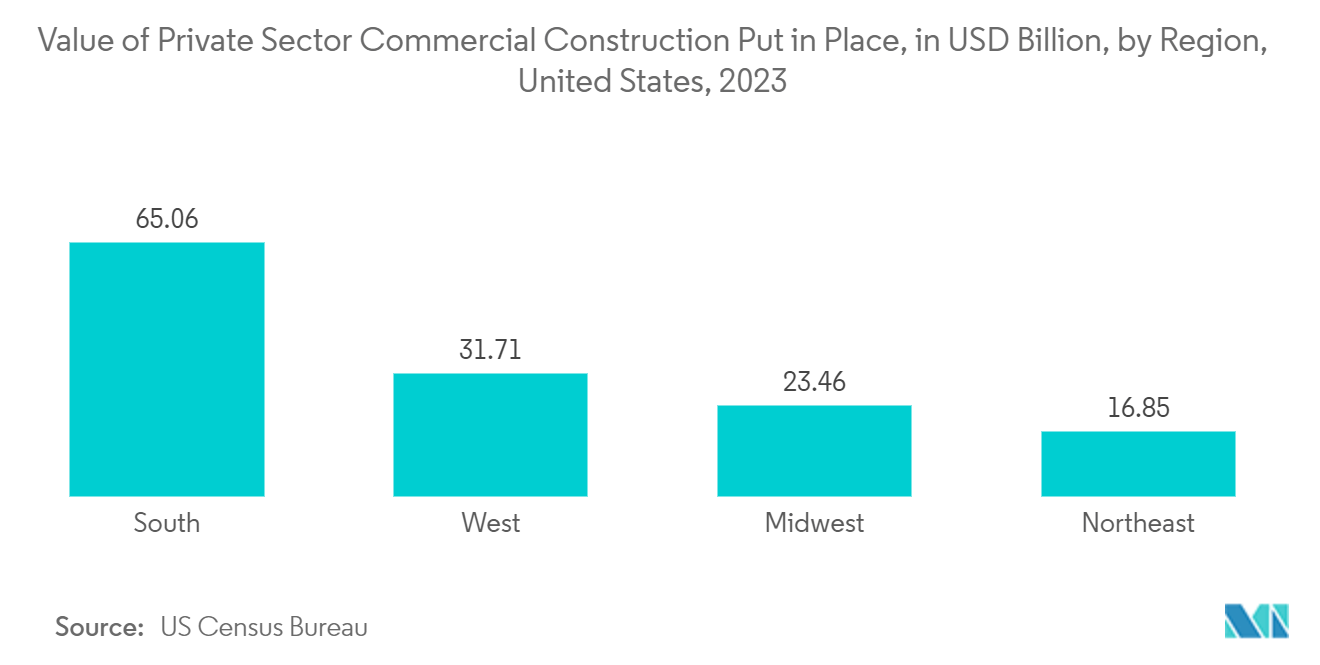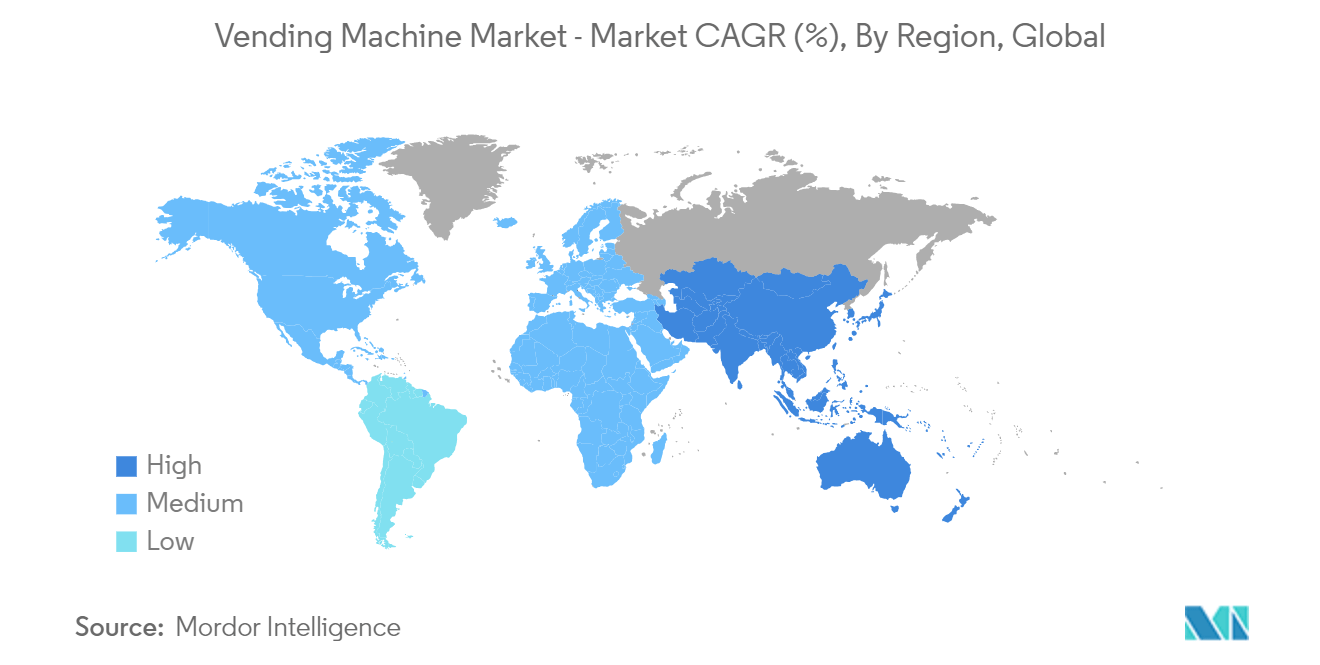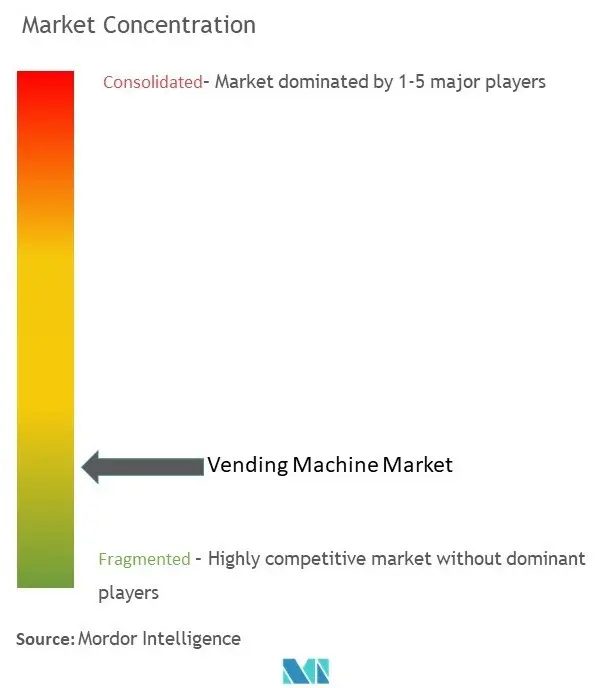Vending Machine Market Size

| Study Period | 2019 - 2029 |
| Market Size (2024) | USD 21.57 Billion |
| Market Size (2029) | USD 27.77 Billion |
| CAGR (2024 - 2029) | 5.18 % |
| Fastest Growing Market | Asia-Pacific |
| Largest Market | North America |
Major Players.webp)
*Disclaimer: Major Players sorted in no particular order |
Vending Machine Market Analysis
The Global Vending Machine Market size is estimated at USD 21.57 billion in 2024, and is expected to reach USD 27.77 billion by 2029, growing at a CAGR of 5.18% during the forecast period (2024-2029).
The vending machine market has significantly evolved due to technological advancements and shifting consumer preferences. Vending machines have become integral to urban environments, providing convenient access to various products, such as beverages, packaged foods, and other essential items. As lifestyles grow busier, the demand for quick, accessible solutions has increased, positioning vending machines as critical retail points in locations such as commercial spaces, corporate offices, amusement parks, and healthcare facilities. These machines offer contactless and cashless purchasing options, aligning with modern consumer behaviors.
Technological advancements have transformed vending machines from basic product dispensers to sophisticated retail solutions. Automated vending machines now provide enhanced user experiences through digital interfaces and advanced payment systems. Innovations like touchless vending machines and cashless payment options boost their appeal in an increasingly hygiene-conscious world. Furthermore, the introduction of smart vending machines, which incorporate real-time inventory monitoring and data analytics, enhances operational efficiency and customer satisfaction.
Demand for Packaged Foods Aligns with Fast-Paced Lifestyles
- Rising demand for quick food solutions: As consumers lead fast-paced urban lives, the demand for vending machines offering quick access to packaged food has surged. These machines are often installed in high-traffic areas such as transport hubs, offices, and educational institutions, making them an attractive option for on-the-go consumers. Food vending machines benefit from the growing preference for ready-to-eat meals and snacks, aligning with the need for quick yet satisfying options.
- Expanded product range meets convenience: The vending machine market caters to consumers seeking convenience by offering a diverse range of products, including snacks and beverages. As cities expand and working hours lengthen, vending machines play a pivotal role in delivering 24/7 food solutions. Their ability to serve customers outside regular store hours increases their utility in high-demand areas.
- Technological adaptability enhances consumer engagement: Advanced vending machine technologies allow operators to track consumer preferences and adjust product offerings in real-time. This responsiveness helps optimize product mixes to reflect popular choices and seasonal demand. Such customization ensures vending machines remain a valuable asset in food retail distribution, maximizing sales potential.
- Smart machines drive food retail innovation: Smart vending machines can adjust product prices, introduce promotions, and tailor offerings based on real-time data analysis. This capability elevates their status as not just convenience solutions but also strategic retail tools that adapt dynamically to consumer behavior.
Technological Investments Broaden Accessibility
- Enhanced inclusivity through tech innovation: The vending machine industry is seeing increased investments in technology aimed at making machines more accessible to differently-abled individuals. Enhanced user interfaces such as voice activation, braille displays, and ergonomic designs improve usability for individuals with disabilities. These innovations expand the customer base, benefiting operators and manufacturers alike.
- Digital integration streamlines operations: Technology investments focus on integrating vending machines with digital platforms for real-time inventory updates, maintenance alerts, and mobile payments. These innovations ensure more efficient operations, reducing downtime due to machine malfunctions. Smart vending machines also provide operators with sales data, enabling better product selection and pricing strategies.
- Cashless payment options grow in popularity: The increasing prevalence of mobile wallets and contactless payments enhances the appeal of cashless vending machines. This trend improves transaction speed and customer safety, especially in public areas where hygiene is a concern. As cashless options become more popular, vending machines equipped with these technologies are well-positioned to attract modern consumers.
- Technological innovations shape future vending machine design: As the demand for touchless and cashless services grows, vending machines with advanced technological features will dominate the market. These machines, which align with the preferences of hygiene-conscious and tech-savvy consumers, ensure that the vending industry remains competitive and forward-looking.
Vending Machine Market Trends
Commercial Places to Witness Increased Installation of Vending Machines
- Commercial places see increased vending machine adoption: The global vending machine market is expanding rapidly, driven by the increasing demand for automated retail solutions in commercial spaces such as offices, malls, airports, and educational institutions. This trend is expected to significantly contribute to the market’s overall size and growth.
- Post-pandemic shift towards contactless solutions: The rising popularity of touchless vending machines, fueled by a preference for contactless services, has accelerated the demand for cashless and touchless vending machines. These devices employ advanced technologies like QR code scanning and mobile payments, providing safer, more hygienic transaction methods that appeal to health-conscious consumers.
- AI and IoT revolutionize vending machine operations: The integration of artificial intelligence (AI) and the Internet of Things (IoT) in smart vending machines has transformed the industry. These technologies enable real-time data analytics, enhancing inventory management and customer satisfaction while optimizing operational efficiency.
- Health-conscious consumers drive product diversification: As demand for healthier snacks and beverages increases, vending machines are expanding their product offerings. Modern machines equipped with advanced cooling and heating systems can now deliver a wider range of products, catering to health-conscious consumers and driving revenue growth.

Asia Pacific Region to Register High Growth
- Asia-Pacific leads in vending machine adoption: Countries like Japan, China, and South Korea have become pivotal players in the global vending machine market due to their robust technological infrastructure and willingness to embrace automation. Japan, in particular, stands out for its innovative vending machines that offer a wide range of products, contributing significantly to regional growth.
- Urbanization fuels demand for vending solutions: Rapid urbanization and a youth-driven population are increasing the demand for vending machines across Asia-Pacific. Cashless machines are particularly popular, and government initiatives supporting digitization further boost market growth.
- Regional investments expand market presence: Vending machine manufacturers are increasingly investing in the Asia-Pacific region to tap into its growing consumer base. Predictions suggest that this region will outpace others in terms of growth, solidifying its position as a key contributor to the global vending machine market forecast.
- Shift toward health-focused vending options: Rising health consciousness among consumers is driving demand for fresh food and beverage vending machines across Asia-Pacific. The growing popularity of healthier drink options further strengthens the market’s growth trajectory, aligning with global trends favoring health and wellness.

Vending Machine Industry Overview
Semi-consolidated market with prominent players: The global vending machine market remains moderately consolidated, with competition dominated by both global conglomerates and regional players. Leading companies like Fuji Electric and Westomatic Vending Services maintain strong market positions by offering diverse product portfolios.
Technological innovation as a competitive edge: Market leaders such as Seaga Manufacturing, Inc. and Azkoyen Vending Systems maintain their dominance through a commitment to innovation and operational efficiency. These companies invest in technologies like cashless payment systems, touchscreen interfaces, and eco-friendly vending machines to meet evolving consumer demands.
IoT-enabled machines drive future success: The adoption of IoT technology and the shift towards AI-enabled machines are key trends in the market. Companies that leverage these innovations to enhance customer engagement and operational efficiency are well-positioned for success in the evolving vending machine landscape.
Personalization and sustainability become strategic priorities: As vending machine manufacturers continue to innovate, strategies focusing on personalized product offerings, advanced payment methods, and sustainability through energy-efficient machines are expected to shape the industry’s future growth.
Vending Machine Market Leaders
-
Westomatic Vending Services Ltd.
-
Fuji Electric Company Ltd.
-
Seaga Manufacturing, Inc.
-
Royal Vendors, Inc.
-
Azkoyen Vending Systems
*Disclaimer: Major Players sorted in no particular order

Vending Machine Market News
- September 2024 - JR East acquired Decorum Vending, which operates vending machines at stations in the UK. JR East plans to expand the number of vending machines installed at transportation hubs to 1,000 units.
- September 2024 - TOMRA Collection launched the TOMRA R2 reverse vending machine for smaller stores. The TOMRA R2 offers features such as digital vouchers and expanded charity donation options.
Vending Machine Market Report - Table of Contents
1. INTRODUCTION
- 1.1 Study Assumptions and Market Definition
- 1.2 Scope of the Study
2. RESEARCH METHODOLOGY
3. EXECUTIVE SUMMARY
4. MARKET INSIGHTS
- 4.1 Market Overview
-
4.2 Industry Attractiveness - Porter's Five Forces Analysis
- 4.2.1 Threat of New Entrants
- 4.2.2 Bargaining Power of Buyers/Consumers
- 4.2.3 Bargaining Power of Suppliers
- 4.2.4 Threat of Substitute Products
- 4.2.5 Intensity of Competitive Rivalry
- 4.3 Industry Value Chain Analysis
- 4.4 Assessment of the Impact of COVID-19 on the Market
5. MARKET DYNAMICS
-
5.1 Market Drivers
- 5.1.1 Increasing Demand for Packaged Food Products Due to Fast-Paced Lifestyle
- 5.1.2 Technological Investments to Enable Greater Support for the Differently Abled Populace and New Users
-
5.2 Market Challenges
- 5.2.1 High Installation and Maintenance Cost
6. MARKET SEGMENTATION
-
6.1 By Technology
- 6.1.1 Automatic Vending Machines
- 6.1.2 Semi-Automatic Vending Machines
-
6.2 By Type
- 6.2.1 Packaged Food
- 6.2.2 Beverages
- 6.2.3 Other Types
-
6.3 By Application
- 6.3.1 Commercial Places
- 6.3.2 Corporate Offices
- 6.3.3 Others (Amusement Parks, Sports Venues, Healthcare Facilities, Transport Facilities, etc.)
-
6.4 By Geography***
- 6.4.1 North America
- 6.4.2 Europe
- 6.4.3 Asia
- 6.4.4 Australia and New Zealand
- 6.4.5 Latin America
- 6.4.6 Middle East and Africa
7. COMPETITIVE LANDSCAPE
-
7.1 Company Profiles*
- 7.1.1 Westomatic Vending Services Ltd.
- 7.1.2 Fuji Electric Company Ltd.
- 7.1.3 Seaga Manufacturing, Inc.
- 7.1.4 Royal Vendors, Inc.
- 7.1.5 Azkoyen Vending Systems
- 7.1.6 Crane Merchandising Systems Inc
- 7.1.7 Vending.com
- 7.1.8 JOFEMAR SA
- 7.1.9 EVOCA Group
- 7.1.10 GUANGZHOU BAODA INTELLIGENT TECHNOLOGY CO., LTD
- 7.1.11 Armark Corporation
8. INVESTMENT ANALYSIS
9. FUTURE OF THE MARKET
** Subject To AvailablityVending Machine Industry Segmentation
Vending Machines are automated machines that dispense food, beverages, medical products, etc. The report offers a detailed global analysis of the vending machine market segmented by vending machine types, technology, application, and geography.
The vending machine market is segmented by technology (automatic vending machine, semi-automatic vending machine), by type (packaged food, beverage), by application (commercial places, corporate offices), and by geography (North America, Europe, Asia Pacific, Latin America, Middle East and Africa). The Report Offers Market Forecasts and Size in Value (USD) for all the Above Segments.
| By Technology | Automatic Vending Machines |
| Semi-Automatic Vending Machines | |
| By Type | Packaged Food |
| Beverages | |
| Other Types | |
| By Application | Commercial Places |
| Corporate Offices | |
| Others (Amusement Parks, Sports Venues, Healthcare Facilities, Transport Facilities, etc.) | |
| By Geography*** | North America |
| Europe | |
| Asia | |
| Australia and New Zealand | |
| Latin America | |
| Middle East and Africa |
Vending Machine Market Research FAQs
How big is the Global Vending Machine Market?
The Global Vending Machine Market size is expected to reach USD 21.57 billion in 2024 and grow at a CAGR of 5.18% to reach USD 27.77 billion by 2029.
What is the current Global Vending Machine Market size?
In 2024, the Global Vending Machine Market size is expected to reach USD 21.57 billion.
Who are the key players in Global Vending Machine Market?
Westomatic Vending Services Ltd., Fuji Electric Company Ltd., Seaga Manufacturing, Inc., Royal Vendors, Inc. and Azkoyen Vending Systems are the major companies operating in the Global Vending Machine Market.
Which is the fastest growing region in Global Vending Machine Market?
Asia-Pacific is estimated to grow at the highest CAGR over the forecast period (2024-2029).
Which region has the biggest share in Global Vending Machine Market?
In 2024, the North America accounts for the largest market share in Global Vending Machine Market.
What years does this Global Vending Machine Market cover, and what was the market size in 2023?
In 2023, the Global Vending Machine Market size was estimated at USD 20.45 billion. The report covers the Global Vending Machine Market historical market size for years: 2019, 2020, 2021, 2022 and 2023. The report also forecasts the Global Vending Machine Market size for years: 2024, 2025, 2026, 2027, 2028 and 2029.
Vending Machine Industry Report
Global Vending Machine Market Research
Our comprehensive global vending machine market research provides an in-depth analysis of the industry's evolving trends, growth factors, and technological innovations. The report covers key aspects such as automated and smart vending machine advancements, which are reshaping the retail landscape by offering cashless, touchless, and AI-driven solutions. Detailed insights into the food and beverage vending machine sectors, alongside emerging trends like health-conscious product diversification, make this industry report invaluable for stakeholders. The research includes a forecast on regional growth, particularly in Asia-Pacific, where increased urbanization and technological integration are accelerating market expansion.
Stakeholders will benefit from data-driven recommendations on optimizing operations, product offerings, and consumer engagement strategies. The report highlights critical information on leading market players and their competitive strategies, with a focus on the integration of IoT and AI for enhanced inventory management and customer satisfaction. Available in an easy-to-read report pdf format, this industry analysis offers actionable insights that help manufacturers, investors, and retailers navigate the future of vending machine technology and capitalize on growth opportunities across key markets.



